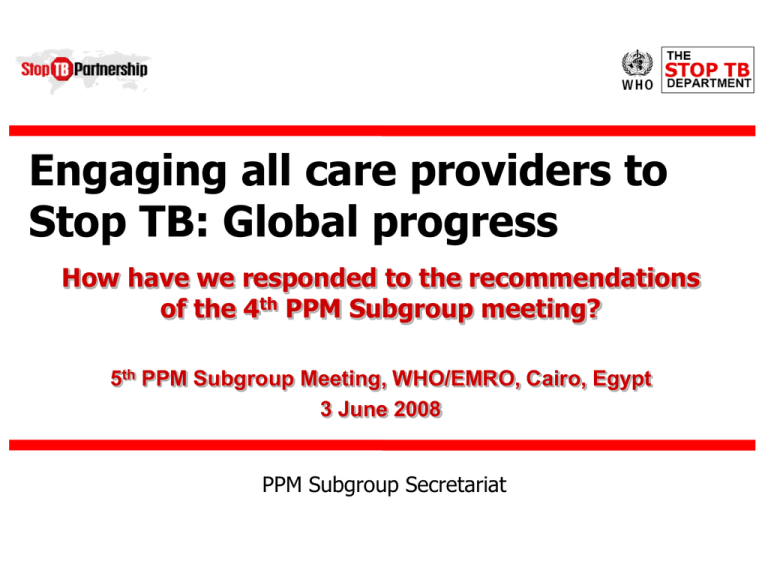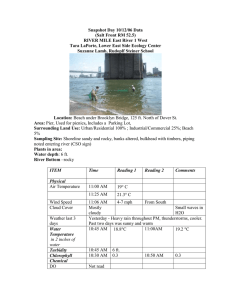Engaging all care providers to Stop TB: Global progress of the 4
advertisement

Engaging all care providers to Stop TB: Global progress How have we responded to the recommendations of the 4th PPM Subgroup meeting? 5th PPM Subgroup Meeting, WHO/EMRO, Cairo, Egypt 3 June 2008 PPM Subgroup Secretariat Recommendation 1: Coordinate with partners to implement recommendations • Core Group consultations at Union conferences and Subgroup meetings • TB CAP: Projects development and collaborative implementation (IR3 – APA:1-3; 4) • Potentially, through TBTEAM mechanism Recommendation 2: Promote PPM guidance and tools • Thirteen countries have developed PPM guidelines • National situation assessments undertaken in 11 countries from AFR and EMR • PPM operational planning workshop for 11 countries in AFR and EMR • Spanish translation of the guidance document under print, French translation under way. Recommendation 3: Promote International Standards for TB Care • Largely driven by ATS in collaboration with partners • Endorsements obtained and translated widely • Pilots in India, Indonesia, Kenya, Mexico, Tanzania • User guide and training modules developed • Revision under way Recommendation 4: Prepare guidance on involving hospitals in TB control • Process led by KNCV • Preliminary draft developed • Shared and discussed in a multi-country workshop in 2007 • Draft revised based on feedback and input • To be discussed in this meeting Recommendation 5: Conduct training on PPM at various levels • 3rd PPM international consultants training course, Sondalo, Italy, April 08 • Regional training course for 9 countries in WPR; preparation on for a training course for Francophone countries • Country specific courses / workshops: preparation on for a workshop for NGOs in India • PPM incorporated into international courses on TB: Sondalo; RIT Recommendation 6: Provide technical support to countries for PPM • AFR: Malawi, Nigeria, Ghana • AMR: Mexico • EMR: Pakistan • SEAR: Bangladesh, India, Indonesia, Nepal • WPR: China, Philippines, Vietnam Recommendation 7: Help develop guidance on PPM for TB/HIV • Literature review • PPM TB/HIV consultations • PPM TB/HIV draft protocol for piloting • Union to pilot in India and Namibia • Protocol to be made available on the web • Technical support available Recommendation 8: Link with MDR-TB Working Group and Laboratory Subgroup • Joint Group on PPM MDR-TB proposed • Links with the Lab Subgroup established • Working examples of PPM Labs yet to be studied (India, Iran) • Collaboration with FIND on private laboratories engagement on Uganda Recommendation 9: Document and develop strategies to involve informal providers • Partly supported through TB CAP project • Literature review • Documentation in Burkina Faso and Gambia • Documentation in more countries planned • Intervention project planned in Gambia Recommendation 10: Enhance efforts to engage corporate sector • Literature review undertaken • Country examples documented: Bangladesh, Philippines; more planned (Kenya, South Africa, Brazil ?, India ?) • Multi-agency Task Force set up: UNAIDS, ILO, WEF, WHOOccupational Health, Stop TB Partnership • Company self-assessment tool developed and piloted • Joint Consultation with countries and business sector planned Recommendation 11: Pursue operational research agenda • India: Scale up documentation • India: Economic analysis of scale up • TB – – – CAP Projects: Informal providers Corporate sector PPM TB/HIV Recommendation 12: Collaborate with and learn from other health programmes • WHO Technical Brief on private sector • PPM Malaria • Sharing of experiences • Reproductive health • WHO working group on contracting • Journal editorials and articles and book chapter Recommendation 13: Develop and use a knowledge management strategy • PPM Web Site • Web Learning Laboratory Recommendation 14: Strengthen advocacy efforts • PPM Brochure updated • PPM Website maintained Expectations from PPM: Global Plan 2006-2015 100 5000 80 4000 70 60 3000 50 40 2000 30 20 1000 10 0 0 2005 2006 2007 2008 2009 2010 2011 2012 2013 2014 2015 PPM Proportion of population covered (%) Population to be covered (millions) 90 Community DOTS PAL Quality assured culture and DST Proportion of BMUs with PPM in place: top 5 high burden countries, 2007 100 97 100 100 80 53 60 40 20 1 0 India China Indonesia Nigeria Bangladesh PPM resources and progress in 22 HBCs : 2007 20 15 14 13 12 10 10 8 5 0 National PPM Focal Person PPM Guidelines Scaling Up GF Support Training for PPM Material for PPM What precisely is the contribution of PPM to Global TB control? ? Key issues before this meeting • Linking hospitals • Engaging professional associations • Involving business sector • PPM for MDR-TB and TB/HIV working groups • Tapping new opportunities and resources • Measuring PPM contributions


